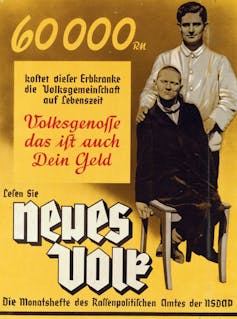The modern ethical debate about human gene editing can be traced back to the post World War II era. The debate is a slippery slope.
It appears that researchers in China have facilitated the birth of the first “designer baby” – actually babies, twin girls who are supposedly genetically resistant to HIV. The scientist who created the embryos, as well as some American scientists like Harvard’s George Church, have praised the beneficent intent to producing a child who is resistant to disease. Who could argue with such good intentions?
But, once you can do this with one gene, you could someday do it with any gene – like those linked with educational attainment. Those who praise the Chinese research have given no mechanism, or rules and regulations, that would allow human gene editing for only beneficent purposes. As the old proverb says, “The road to hell is paved with good intentions.”
For over 20 years I have focused my research on debates about human gene editing and other biotechnologies. I have watched these debates unfold, but I am shocked by the recent speed of developments.
The Chinese scientist, He Jiankui, claimed to have altered embryos for seven couples during fertility treatment in China. His goal was to disable a gene that encodes a gateway protein that allows the HIV virus to enter a cell. A woman nurtured two of those embryos and this month gave birth to non-identical twin girls who would, according to He, be resistant to HIV.

Given the secrecy involved, it is difficult to verify He’s claim. The research wasn’t published in a peer-reviewed journal, the parents of the twins refused to speak with the media, and no one has tested the DNA of the girls to verify what He says is true. But what is more important for now is that there are scientists trying to create these enhanced humans who could pass on this trait to their offspring.
Mainline and reform eugenics
Creating an “improved” human species has long been the dream of eugenicists. The mainline, old school version of eugenics assumed that superior traits were found in particular races, ethnicities, and particularly in the United Kingdom, social classes. This logic culminated in the Holocaust where the Nazis concluded that some ethnic groups are genetically superior to others, and that the “inferior” ones should be exterminated and completely erased.

The revelation of the Holocaust destroyed mainline eugenics, but a “reform” eugenics arose in its wake in the 1950s. This brand of eugenics assumed that “superior traits” could be found among all ethnic groups. All that needed to happen was to get these superior people to produce more children and discourage those with inferior traits from reproducing. This turned out to be difficult.
But in the early 1950s, Francis Crick and James Watson discovered the chemical structure of DNA, which suggested that the genes of humans could be improved through chemical modification of their reproductive cells. A typical response was from prominent biologist Robert Sinsheimer who wrote in 1969 that the new genetic technologies of the time allowed for “a new eugenics.” According to Sinsheimer, the old eugenics required selecting fit individuals to breed and culling the unfit. “The new eugenics would permit in principle the conversion of all of the unfit to the highest genetic level … for we should have the potential to create new genes and new qualities yet undreamed.”
The slippery slope of the human gene editing debate
The modern ethical debate about human gene editing can be traced back to this era. The debate was implicitly set up like a slippery slope.
At the top of the slope was an act of gene editing deemed indisputably virtuous – a step most people were willing to take – such as repairing sickle cell anemia. However, the slope was slippery. It is very difficult to say that changing other traits that are not deadly, like deafness, are not equally acceptable. Once you figure out how to change one gene, you can change any gene, regardless of its function. If we fix sickle cell, why not deafness, or late onset heart disease, or a lack of “normal” intelligence, or as we approach the bottom, a lack of superior intelligence?

At the bottom of the slope was the dystopian world where nobody wants to end up. This is typically depicted as a society based on total genetic control of offspring where people’s lives and opportunities are determined by their genetic pedigree. Today the bottom of the slope is represented by the late 1990s movie “Gattaca.”
Stepping onto the slope
In the 1970s, essentially all of the participants in the debate stepped onto the slope and approved of somatic gene therapy – a strategy for healing genetic diseases in the bodies of living people where genetic changes would not be passed to any offspring. Participants in the ethical debate about gene editing stepped onto this slope because they were confident that they had blocked any possible slide by creating a strong norm against the modification of DNA that passed to the next generation: the germline wall. (The germline means influencing not only the person modified, but their descendants.)
Somatic changes could be debated, but researchers would not move beyond the wall to change people’s inheritance – to change the human species as the eugenicists had long desired. Another barrier to the road to hell that turned out to be permeable was the wall between blocking disease and enhancing an individual. Scientists could try to use gene editing to avoid genetic diseases, like sickle cell disease, but not to create “improved” humans.
The recent actions of the Chinese scientist leap over both the germline and the enhancement walls. It is the first known act of human germline gene editing. These twin girls may pass their newfound resistance to HIV to their own children. It is also not meant to avoid a genetic disease like sickle cell anemia, but to create an enhanced human, albeit an enhancement made in the name of fighting infectious disease.
Calling for a new wall
Unlike in earlier years of the human gene editing debate, we are given no argument for where these applications would stop. Those advocating the Chinese scientist’s use of gene editing do not point to a wall further down the slope that can be used to reassure ourselves that by allowing this presumably beneficent application we will not eventually end up at the bottom. Many scientists seem to think that a wall can be constructed with “disease” applications in the acceptable part of the slope and “enhancement” in the unacceptable part below.
However, how one defines “disease” is notoriously fluid, with pharmaceutical companies frequently creating new diseases to be treated in a process sociologists call medicalization. Moreover, is deafness a disease? Many deaf people do not think so. We also cannot simply rely upon the medical profession to define disease, as some practitioners are engaged in activities that are more aptly described as enhancement (think plastic surgery). A recent report by the National Academy of Sciences concluded that the distinction between disease and enhancement is hopelessly muddled.
So, while the scientists defending the first enhanced baby may be right that this is a moral good, unlike previous debaters they have given society no walls or barriers that allow us to confidently walk on to this new slippery slope. It is just dodging responsibility to say that “society will decide what to do next,” as did He, or to say that the research “is justifiable,” without defining a limit, as did Harvard University’s George Church.
For a responsible debate, participants must state not only their conclusion about this particular act of enhancement, but also where they will build a wall and, critically, how this wall will be maintained in the future.
John Evans, Professor of Sociology, University of California San Diego
This article is republished from The Conversation under a Creative Commons license. Read the original article.

